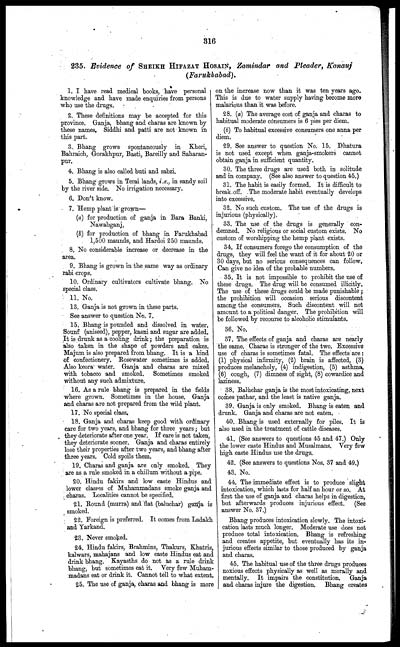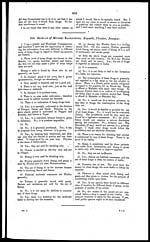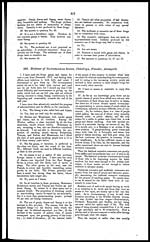Medicine - Drugs > Report of the Indian Hemp Drugs Commission, 1894-1895 > Volume V
(336) Page 316
Download files
Individual page:
Thumbnail gallery: Grid view | List view

316
235. Evidence of SHEIKH HIFAZAT HOSAIN, Zamindar and Pleader, Kanauj
(Farukhabad).
1. I have read medical books, have personal
knowledge and have made enquiries from persons
who use the drugs.
2. These definitions may be accepted for this
province. Ganja, bhang and charas are known by
these names. Siddhi and patti are not known in
this part.
3. Bhang grows spontaneously in Kheri,
Bahraich, Gorakhpur, Basti, Bareilly and Saharan-
pur.
4. Bhang is also called buti and sabzi.
5. Bhang grows in Terai lands, i.e., in sandy soil
by the river side. No irrigation necessary.
6. Don't know.
7. Hemp plant is grown—
(a) for production of ganja in Bara Banki,
Nawabganj,
(b) for production of bhang in Farukhabad
1,500 maunds, and Hardoi 250 maunds.
8. No considerable increase or decrease in the
area.
9. Bhang is grown in the same way as ordinary
rabi crops.
10. Ordinary cultivators cultivate bhang. No
special class.
11. No.
13. Ganja is not grown in these parts.
See answer to question No. 7.
15. Bhang is pounded and dissolved in water.
Sounf (aniseed), pepper, kasni and sugar are added.
It is drunk as a cooling drink; the preparation is
also taken in the shape of powders and cakes.
Majum is also prepared from bhang. It is a kind
of confectionery. Rosewater sometimes is added.
Also keora water. Ganja and charas are mixed
with tobacco and smoked. Sometimes smoked
without any such admixture.
16. As a rule bhang is prepared in the fields
where grown. Sometimes in the house. Ganja
and charas are not prepared from the wild plant.
17. No special class.
18. Ganja and charas keep good with ordinary
care for two years, and bhang for three years; but
they deteriorate after one year. If care is not taken,
they deteriorate sooner. Ganja and charas entirely
lose their properties after two years, and bhang after
three years. Cold spoils them.
19. Charas and ganja are only smoked. They
are as a rule smoked in a chillum without a pipe.
20. Hindu fakirs and low caste Hindus and
lower classes of Muhammadans smoke ganja and
charas. Localities cannot be specified.
21. Bound (murra) and flat (baluchar) ganja is
smoked.
22. Foreign is preferred. It comes from Ladakh
and Yarkand.
23. Never smoked.
24. Hindu fakirs, Brahmins, Thakurs, Khatris,
kalwars, mahajans and low caste Hindus eat and
drink bhang. Kayasths do not as a rule drink
bhang, but sometimes eat it. Very few Muham-
madans eat or drink it. Cannot tell to what extent.
25. The use of ganja, charas and bhang is more
on the increase now than it was ten years ago.
This is due to water supply having become more
malarious than it was before.
28. (a) The average cost of ganja and charas to
habitual moderate consumers is 6 pies per diem.
(b) To habitual excessive consumers one anna per
diem.
29. See answer to question No. 15. Dhatura
is not used except when ganja-smokers cannot
obtain ganja in sufficient quantity.
30. The three drugs are used both in solitude
and in company. (See also answer to question 45.)
31. The habit is easily formed. It is difficult to
break off. The moderate habit eventually develops
into excessive.
32. No such custom. The use of the drugs is
injurious (physically).
33. The use of the drugs is generally con-
demned. No religious or social custom exists. No
custom of worshipping the hemp plant exists.
34. If consumers forego the consumption of the
drugs, they will feel the want of it for about 20 or
30 days, but no serious consequences can follow.
Can give no idea of the probable numbers.
35. It is not impossible to prohibit the use of
these drugs. The drug will be consumed illicitly.
The use of these drugs could be made punishable;
the prohibition will occasion serious discontent
among the consumers. Such discontent will not
amount to a political danger. The prohibition will
be followed by recourse to alcoholic stimulants.
36. No.
37. The effects of ganja and charas are nearly
the same. Charas is stronger of the two. Excessive
use of charas is sometimes fatal. The effects are:
(1) physical infirmity, (2) brain is affected, (3)
produces melancholy, (4) indigestion, (5) asthma,
(6) cough, (7) dimness of sight, (8) cowardice and
laziness.
38. Baluchar ganja is the most intoxicating, next
comes pathar, and the least is native ganja.
39. Ganja is only smoked. Bhang is eaten and
drunk. Ganja and charas are not eaten.
40. Bhang is used externally for piles. It is
also used in the treatment of cattle diseases.
41. (See answers to questions 45 and 47.) Only
the lower caste Hindus and Musalmans. Very few
high caste Hindus use the drugs.
42. (See answers to questions Nos. 37 and 49.)
43. No.
44. The immediate effect is to produce slight
intoxication, which lasts for half an hour or so. At
first the use of ganja and charas helps in digestion,
but afterwards produces injurious effect. (See
answer No. 37.)
Bhang produces intoxication slowly. The intoxi-
cation lasts much longer. Moderate use does not
produce total intoxication. Bhang is refreshing
and creates appetite, but eventually has its in-
jurious effects similar to those produced by ganja
and charas.
45. The habitual use of the three drugs produces
noxious effects physically as well as morally and
mentally. It impairs the constitution. Ganja
and charas injure the digestion. Bhang creates
Set display mode to: Large image | Zoom image | Transcription
Images and transcriptions on this page, including medium image downloads, may be used under the Creative Commons Attribution 4.0 International Licence unless otherwise stated. ![]()
| India Papers > Medicine - Drugs > Report of the Indian Hemp Drugs Commission, 1894-1895 > Volume V > (336) Page 316 |
|---|
| Permanent URL | https://digital.nls.uk/75121836 |
|---|
| Description | Volume 5: Evidence of witnesses from North-Western Provinces and Oudh and Punjab. Answers from witnesses in North-Western Provinces, Oudh and Punjab about cultivation and growth of hemp, preparation or manufacture, trade, consumption or use, effects, administration - taxation and control. |
|---|---|
| Attribution and copyright: |
|




